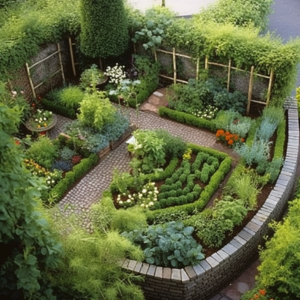The best layout for a vegetable garden depends on various factors such as available space, sunlight exposure, soil quality, and personal preferences. However, here is a general guideline for designing an efficient and productive vegetable garden layout:
Sunlight:
Most vegetables require at least 6-8 hours of direct sunlight per day. Locate your garden in an area that receives ample sunlight, preferably facing south to maximize exposure.
Vegetable Garden Bed Design:
Raised beds or traditional in-ground beds are common choices. Raised beds offer better drainage, and easier access, and can be more visually appealing. Aim for a width of 3-4 feet, which allows you to comfortably reach the center from both sides.
Pathways:
Incorporate pathways between garden beds to provide access without compacting the soil. Pathways should be wide enough for easy movement, typically around 18-24 inches.
Crop Rotation:
Practice crop rotation to minimize disease and nutrient depletion. Divide your garden into different sections and rotate crops within each section every year. Avoid planting crops from the same family in the same location year after year.
Companion Planting in your Vegetable Garden:
Some plants grow better when planted near certain companion plants, while others may inhibit each other’s growth. Consider companion planting to maximize space utilization and enhance plant health. For example, plant tall crops (like corn or trellised beans) on the north side to avoid shading smaller plants.
Vertical Gardening:
Utilize vertical space by growing climbing plants such as beans, peas, cucumbers, and tomatoes on trellises or vertical supports. This helps maximize productivity and makes efficient use of space.
Watering and Irrigation:
Plan for efficient watering by locating your garden near a water source and installing a convenient irrigation system. Drip irrigation or soaker hoses are ideal for delivering water directly to plant roots while minimizing water waste.
Accessibility:
Consider your own physical capabilities when designing the garden layout. Leave enough space for you to walk easily, especially if you use garden tools or have specific accessibility needs.
Succession Planting:
Stagger your planting times and consider succession planting to extend the harvest season and maximize productivity. As one crop finishes, replant the area with another suitable crop.
Keeping detailed Records:
Maintain a garden journal or record system to track what you plant, where you plant it, and the results obtained. This information will be valuable for future planning and improving your garden layout.
Soil Preparation:
Before planting, assess your soil’s quality and amend it if necessary. Test the soil pH and nutrient levels to determine any deficiencies or imbalances. Add organic matter like compost, well-rotted manure, or other soil amendments to improve soil structure, fertility, and drainage.
Plant Spacing:
Follow the recommended spacing guidelines for each vegetable you plan to grow. Overcrowding can lead to competition for nutrients, increased pest and disease issues, and reduced yields. Adequate spacing ensures proper air circulation and sunlight penetration.
Weeding:
Regularly remove weeds from your vegetable garden as they compete with plants for water, nutrients, and sunlight. Mulching can help reduce weed growth. Consider using organic weed control methods like hand weeding, hoeing, or mulch.
Pest Management:
Monitor your garden regularly for pests like insects, slugs, snails, or diseases. Identify the specific pests and choose appropriate control methods, such as organic insecticides, companion planting, or physical barriers. Encourage beneficial insects and birds that help control pest populations.
Harvesting:
Harvest your vegetables at the optimal time to enjoy the best flavor and quality. Different vegetables have different maturity indicators, such as color, size, or texture. Regularly harvest mature crops to encourage continuous production.
Crop Diversity:
Include a variety of vegetables in your garden to enjoy a diverse harvest and reduce the risk of widespread crop failure. Mixing different crops can also help deter pests and promote beneficial interactions.
Season Extension:
If you want to extend your growing season, consider using techniques like row covers, cold frames, or greenhouses. These structures can protect plants from frost and provide a longer growing period.
Organic Gardening:
Consider practicing organic gardening methods, and avoiding synthetic fertilizers and pesticides. Organic gardening promotes soil health, reduces chemical exposure, and supports beneficial organisms in the ecosystem.
Continuous Learning:
Gardening is a continuous learning process. Stay curious, read books, watch videos, join local gardening communities, and learn from experienced gardeners. Adapt your techniques and approaches based on your experiences and observations.
Remember, gardening is a rewarding and enjoyable endeavor, but it requires patience and ongoing care. Embrace the process and have fun experimenting with different techniques and varieties in your vegetable garden.
